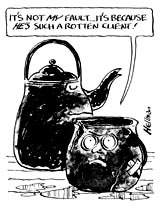The Faults Start to Show
David Bernstein doesn’t hate all design, it’s just that there’s more bad design than good. And you don’t notice inspired designs because they’re too busy solving your problems

“It’s about time you wrote something positive,” she said. Not Lynda Relph-Knight, but my other editor and sleeping partner. “Otherwise you’ll be known as the Victor Meldrew of Design Week.”
She had a point I suppose. My columns had criticised typography in theatre programmes and lettering on railway posters, not to mention a certain airline’s tailfins.
“Isn’t there any design you actually like?”
Now the trouble with design you like is that you have to be particularly perceptive to appreciate it, not to take it for granted. What you actually notice is the design which annoys you, which doesn’t work. The streamlined wash basin which facilitates cleaning and the effortless slipping of the soap from the lipless edge into the basin.
The term for this is “design fault”. Ordinary people use the term. But how often do they use the opposite? Come to think of it, what is the opposite?
“Yes,” I replied. “My Parker 51.” A sublime fusion of form and function. It looks smooth and writes smoothly. Its hooded nib is protective and distinctive. The name, or rather the number, celebrated the Festival of Britain. The pen I’m using to draft this column is 40 years old. I should add that I e-mailed the final copy on another Bernstein Design Award, the I-Mac. You have to hand it to Apple. Despite the vagaries of its history it has maintained its cheekiness and wit, its personality.
I received a witty gift in lieu of a Christmas card last year from a designer friend in Denmark. Knowing my liking for wine, she sent me a Drop Stop, a three-inch diameter circle of thin aluminium foil. Coil it into the top of the bottle. Simple, washable and far more practical than those metal attachments.
The author of a book on innovation advised would-be inventors to go through a day jotting down anything that annoyed them.
I tried it. I was so annoyed by 8am I didn’t continue. I was convinced that the reason for the poor state of the nation’s teeth was an inability to penetrate toothbrush packaging. I remain amazed by the lack of any discernible correlation between the capacity of the triangular coffee filter in its plastic container and that of a standard mug. I underfill, overfill, rarely fill.
The annoyance exercise is worthwhile if only to reassure designers that their business isn’t finite. A hundred years ago, smug Victorians assumed that everything had already been invented. As long as there are practical, everyday problems there will be work for designers.
Though problem solving is one legitimate definition of design, it is by no means all of the job. In The design agenda: A guide to successful design, an admirable (not just because the authors quote me) book, Rachel Cooper and Mike Press decide that the first two stages in the creative process of design are formulating and understanding the problem.
My favourite example of falling down on those areas is from Edward De Bono. He illustrates straight-line, as opposed to lateral, thinking by tracing the history of car directional signals. The earliest signals, based on horse travel, were made by the driver’s arm. Then followed the orange lever that elevated to the horizontal on each side of the car to indicate turning. That was a perfect solution – to the wrong problem, ie how to replace the arm.
The real problem was how to indicate direction. The technology for intermittent lighting already existed.
Formulating and understanding the problem is a game anyone can play. Examine any design item and work backwards. Ask why? Why is this thing the way it is? Why in this material/ shape/ size/ colour? Why here and nowhere else?
It’s a good way of passing the time stuck in a traffic jam opposite a building, ad or piece of street furniture. Or on a station platform.
Which brings Victor Meldrew neatly back to East Croydon station. New, hi-tech, attractive, it won a design award. I bet none of the jury actually spent a morning as a customer. Rainy, and there are signs warning of slippery surfaces. Sunny, and the glare through the glass roof completely obliterates the messages on the visual display screens.
However, turn your back, and you may see outside the forecourt the first of the new trams on a trial run. The last London tram ran a year after the Festival of Britain, back in 1952. There were tears at its going, but that was progress wasn’t it? As we approach the next festival it returns, new, improved and a sign of progress.
“Hey,” I said. “There’s something I can be positive about in November – the tram!”
-
Post a comment




